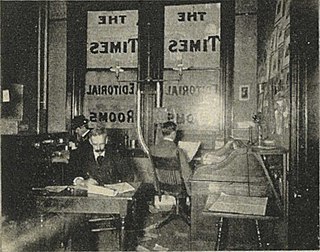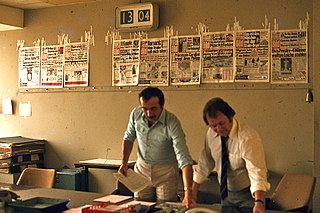
A book is a medium for recording information in the form of writing or images, typically composed of many pages bound together and protected by a cover. The technical term for this physical arrangement is codex. In the history of hand-held physical supports for extended written compositions or records, the codex replaces its predecessor, the scroll. A single sheet in a codex is a leaf and each side of a leaf is a page.

Printing is a process for mass reproducing text and images using a master form or template. The earliest non-paper products involving printing include cylinder seals and objects such as the Cyrus Cylinder and the Cylinders of Nabonidus. The earliest known form of printing as applied to paper was woodblock printing, which appeared in China before 220 AD for cloth printing. However, it would not be applied to paper until the seventh century. Later developments in printing technology include the movable type invented by Bi Sheng around 1040 AD and the printing press invented by Johannes Gutenberg in the 15th century. The technology of printing played a key role in the development of the Renaissance and the Scientific Revolution and laid the material basis for the modern knowledge-based economy and the spread of learning to the masses.
Desktop publishing (DTP) is the creation of documents using page layout software on a personal ("desktop") computer. It was first used almost exclusively for print publications, but now it also assists in the creation of various forms of online content. Desktop publishing software can generate layouts and produce typographic-quality text and images comparable to traditional typography and printing. Desktop publishing is also the main reference for digital typography. This technology allows individuals, businesses, and other organizations to self-publish a wide variety of content, from menus to magazines to books, without the expense of commercial printing.

Editing is the process of selecting and preparing written, photographic, visual, audible, or cinematic material used by a person or an entity to convey a message or information. The editing process can involve correction, condensation, organisation, and many other modifications performed with an intention of producing a correct, consistent, accurate and complete piece of work.

Typesetting is the composition of text by means of arranging physical type in mechanical systems or glyphs in digital systems representing characters. Stored types are retrieved and ordered according to a language's orthography for visual display. Typesetting requires one or more fonts. One significant effect of typesetting was that authorship of works could be spotted more easily, making it difficult for copiers who have not gained permission.

Print on demand (POD) is a printing technology and business process in which book copies are not printed until the company receives an order, allowing prints of single or small quantities. While other industries established the build to order business model, "print on demand" could only develop after the beginning of digital printing, because it was not economical to print single copies using traditional printing technology such as letterpress and offset printing.
Proofreading is an iterative process of comparing galley proofs against the original manuscripts or graphic artworks to identify transcription errors in the typesetting process. In the past, proofreaders would place corrections or proofreading marks along the margins. In modern publishing, material is generally provided in electronic form, traditional typesetting is no longer used and thus this kind of transcription no longer occurs. Consequently the part played by pure proofreaders in the process has almost vanished: the role has been absorbed into copy editing to such an extent that their names have become interchangeable. Modern copy-editors may check layout alongside their traditional checks on grammar, punctuation and readability.
Copy editing is the process of revising written material (copy) to improve readability and fitness, as well as ensuring that a text is free of grammatical and factual errors. The Chicago Manual of Style states that manuscript editing encompasses "simple mechanical corrections through sentence-level interventions to substantial remedial work on literary style and clarity, disorganized passages, baggy prose, muddled tables and figures, and the like ". In the context of print publication, copy editing is done before typesetting and again before proofreading. Outside traditional book and journal publishing, the term copy editing is used more broadly, and is sometimes referred to as proofreading, or the term copy editing sometimes includes additional tasks.
An advance reading copy, advance review copy, advance reader's edition, advance copy, or a reader's edition is a free copy of a new book given by a publisher to booksellers, librarians, journalists, celebrities, or others, or as a contest or school prize, before the book is printed for mass distribution.

Mr. William Shakespeare's Comedies, Histories, & Tragedies is a collection of plays by William Shakespeare, commonly referred to by modern scholars as the First Folio, published in 1623, about seven years after Shakespeare's death. It is considered one of the most influential books ever published.
The bibliographical definition of an edition is all copies of a book printed from substantially the same setting of type, including all minor typographical variants.

Letterpress printing is a technique of relief printing for producing many copies by repeated direct impression of an inked, raised surface against individual sheets of paper or a continuous roll of paper. A worker composes and locks movable type into the "bed" or "chase" of a press, inks it, and presses paper against it to transfer the ink from the type, which creates an impression on the paper.

Phototypesetting is a method of setting type. It uses photography to make columns of type on a scroll of photographic paper. It has been made obsolete by the popularity of the personal computer and desktop publishing.
Imposition is one of the fundamental steps in the prepress printing process. It consists of the arrangement of the printed product’s pages on the printer’s sheet, in order to obtain faster printing, simplify binding and reduce paper waste.

In printing and typography, hot metal typesetting is a technology for typesetting text in letterpress printing. This method injects molten type metal into a mold that has the shape of one or more glyphs. The resulting sorts or slugs are later used to press ink onto paper. Normally the typecasting machine would be controlled by a keyboard or by a paper tape.

News design is the process of arranging material on a newspaper page, according to editorial and graphical guidelines and goals. Main editorial goals include the ordering of news stories by order of importance, while graphical considerations include readability and balanced, unobtrusive incorporation of advertising.

In graphic design, page layout is the arrangement of visual elements on a page. It generally involves organizational principles of composition to achieve specific communication objectives.

A postprint is a digital draft of a research journal article after it has been peer reviewed and accepted for publication, but before it has been typeset and formatted by the journal.
Pagination, also known as paging, is the process of dividing a document into discrete pages, either electronic pages or printed pages.

Robert Smail's Printing Works is a fully functional Victorian era letterpress printing works in the small Scottish Borders town of Innerleithen, now preserved by The National Trust for Scotland as an Industrial Heritage museum showing visitors the operation of a local printer around 1900 while still carrying out orders for printing and stationery.















